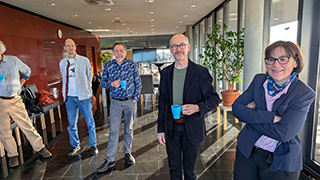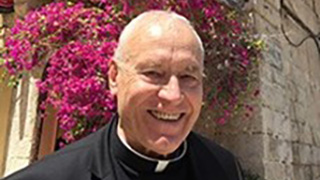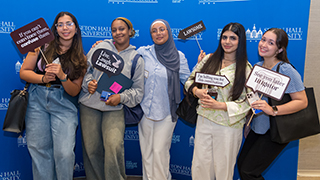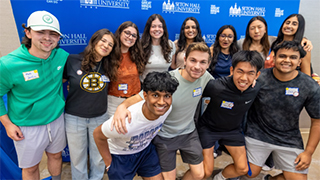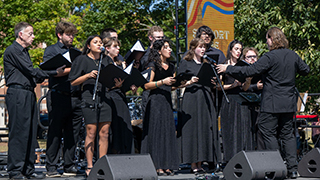5 Questions with a Virologist on COVID-19 - Seton Hall University
Wednesday, March 25, 2020
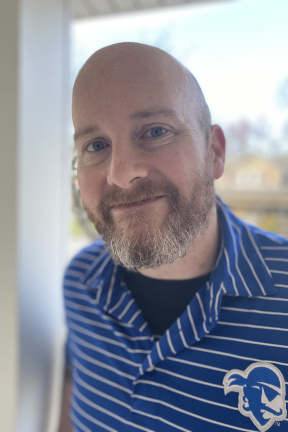
D. Brian Nichols, Ph.D.
As the COVID-19 pandemic continues to progress in the United States and worldwide, many are trying to better understand what the virus is and how it affects humans. D. Brian Nichols, assistant professor in the Department of Biological Sciences at Seton Hall University, has conducted extensive research on virus-host interactions and, specifically, how viruses affect the immune responses of their hosts. He recently addressed these topics as they pertain to COVID-19.
1. COVID-19 is referred to as a "novel virus." Can you tell us what that means and
what impact it has on the effect of the disease on human beings and a potential vaccine?
"Novel" in this context means that it recently emerged to affect humans. It is strongly
believed that bats are the source of the current infectious agent with an unknown
animal likely serving as an intermediate host. Bats harbor a wide variety of coronaviruses
related to the original SARS-CoV. As the human population comes more and more in contact
with these animals, risk of exposure and the risk of viruses that can infect humans
goes up significantly. Coronaviruses are RNA viruses, which means RNA is the genetic
material. Unlike cellular organisms that use DNA as the genetic material, RNA viruses
replicate without significant proofreading of their genetic material. What that means
is that these viruses — which reproduce themselves over and over again — make a lot
of mistakes when the genetic material is copied. Most of these mistakes lead to inactive
viruses that lose the ability to infect cells, but some mistakes result in viruses
that are capable of infecting new hosts. This event likely led to the emergence of
the novel coronavirus, officially designated as SARS-CoV 2, the causative agent of
Covid-19. The most likely scenario at present is that humans came in contact with
animals in Chinese wet markets. The large number of people in contact with exotic
live animals there, combined with butchering these animals in that wet market, created
what could be seen as the perfect environment where the new SARS-CoV 2 could emerge
to infect humans.
Being a new virus that has never circulated in humans before means that vaccine research essentially started when the virus was identified in December 2019. Simply put, until it was identified, there was no virus to design a vaccine against. Normally, vaccines take years to be developed and go through human trials. The fact that we have a vaccine in trials is really amazing and a tribute to the hard work of the researchers who have been studying this virus. As my colleague Dr. Constantine Bitsaktsis, who studies vaccine development, has pointed out, the speed and approval for clinical trials of Covid-19 vaccines is truly unprecedented. However, evaluating the vaccine will take time. Also, the original SARS-CoV emerged in 2003, and generating a vaccine to that virus has proven to be challenging.
2. You specialize in understanding and characterizing virus-host interactions and
viral antagonism of host immune responses. What can you tell us about the virus-host
interactions of COVID-19?
Typically, when viruses infect a cell, the cell activates its innate immune response
to attempt to eradicate viruses. The human body essentially marshals its resources
to fight against what is, in essence, the invasion of a foreign entity. These responses
include inflammation, inducing cell death to destroy both the cell and the virus,
and activating antiviral proteins such as interferon. It can, in some ways, be considered
a "shotgun" approach, with the initial immune response scattering its shot and killing
everything in the vicinity of the threat. All these efforts are in place to try and
contain the infection. Eventually, in what can be thought of as "the next wave" of
defense, the adaptive immune response is activated to destroy any viruses that were
not killed in the initial response. The adaptive response includes B cells producing
antibodies to target and neutralize remaining viruses in the body. For viruses, the
most important part of the adaptive immune response or "next wave" is the activity
of cells called cytotoxic T-cells. These cells are the hunters/killers of the immune
response and take more of a "rifle" approach, actively hunting down cells infected
with viruses and eradicating those particular cells, thereby containing the virus.
In addition, the adaptive response creates memory immune cells, which remain after
the body clears the virus and can activate the immune response much faster on a second
exposure. These memory immune cells are the basis of vaccines and why it is so important
to be immunized against infectious agents.
Viruses, however, are not in the habit of going quietly. Viruses have evolved complex strategies to prevent the body's immune response from activating. In the case of the original SARS-CoV, we know that it blocks the activation of several key immune pathways. By modulating the host's immune response, SARS-CoV was able to ensure a successful infection by escaping the body's defenses.
It's also important to note that things can go wrong on the defense as well. Sometimes the immune system overresponds to infection. I always tell my students to think of the immune system working best in the so-called Goldilocks zone. Too little of an immune response and the virus is not cleared. Too much and the body's own immune response damages the body trying to clear the virus.
3. What can you tell us about host immune responses in humans to COVID-19?
There's a lot we don't know at the moment. It's likely that in some individuals, the
immune response is not strong enough to kill the virus, and as the virus replicates
it destroys the lungs, leading to severe complications and possibly even death. In
others, it seems to be that the virus induces a cytokine storm. Cytokines are produced
by immune cells to communicate and coordinate responses to infectious agents. In these
patients, too much cytokines results in an immune response that damages the patient's
own body, leading to severe complications. This scenario may be responsible for a
number of the severe cases and even mortality among those who seem to otherwise healthy.
To use the Goldilocks analogy, this would be a case of the porridge being too hot.
The cytokine storm is not unique to SARS-CoV 2. This event has been noted in other
great pandemics including the 1918 Spanish Flu, Avian Influenza, and the original
SARS-CoV. The reasons why some individuals have an over-active immune response against
severe human coronaviruses such as SARS-CoV, MERS-CoV, and SARS-CoV 2 is still poorly
understood. What is known is that when this event is triggered, the body's own innate
immune responses in the shotgun approach to eradicate the virus trigger acute lung
injury which can in some cases be fatal. In a patient dealing with chronic diseases,
this event may be too much to overcome and may at least partially explain why individuals
with certain pre-existing conditions have higher mortality ratios.
4. Removing for a moment age and underlying health conditions, why is the virus affecting
different people so differently?
There's a variety of factors likely at play, many of which are still in the process
of coming to light through scientific enquiry and testing. I think it is worth mentioning
that most cases of Covid-19 are very mild. I am also mindful that mild means many
things to different people. In mild cases it can range from signs and symptoms akin
to a severe flu, to signs and symptoms similar to that of the common cold. Many patients
also report mild pneumoniae, which is still significant, but does not require hospitalization.
In addition, people may become infected and never even know they have it. Many people
infected with SARS-CoV 2 are completely asymptomatic and would never know they had
it in the absence of a test. Fortunately, children seem to be the latter, though there
have been some exceptions usually involving pre-existing conditions. On that note,
it is known that age is a factor, which can be reproduced using mice in the lab. The
older the patient gets, the more likely the risk of severe complications, with patients
over 60 experiencing the most significant complications with the disease.
5. There seems to have been some success in treating the coronavirus with some drugs,
including the malaria drug chloroquine and favipiravir. Can you tell us more about
that and why these drugs may work in halting the disease in individuals?
Favipiravir inhibits the RNA-dependent RNA polymerase of several notable RNA viruses
including the influenza virus. The RNA-dependent RNA polymerase is an enzyme encoded
in the viral genome and produced by the cell during infection. The function of the
RNA-dependent RNA polymerase is to replicate the viral RNA genetic material which
is used to make progeny viruses. Without the RNA-dependent RNA polymerase, the virus
cannot successfully replicate in the cell and produce more viruses. For that reason,
this enzyme makes a very attractive target for the development of antiviral drugs
because it is 1.) vital for the virus during replication and 2.) an enzyme that is
not present in a health host cell. Therefore, drugs that directly attack this enzyme
will kill the virus with minimal effects on host cells. Both the influenza virus and
SARS-CoV 2 are RNA viruses and thus use a similar RNA-dependent RNA polymerase to
accomplish the task of replicating the viral genetic material. That said, the influenza
virus and SARS-CoV 2 are very different RNA viruses, and it is very important to note
this fact. Aside from favipiravir, there's a drug called remdesivir that also targets
coronavirus RNA-dependent RNA polymerases. Remdesivir is also being evaluated as an
anti-SARS-CoV 2 therapeutic agent. It's currently under trials, and both antivirals
are still far too early in testing to definitively say they will reverse the increasing
number of SARS-CoV 2 cases in the world. It's also important to remember that due
to the nature of the SARS-CoV 2 RNA-dependent RNA polymerase making mistakes during
replication, it is inevitable that drug resistant populations of viruses will emerge.
The presence of the antiviral may "select" for drug resistant populations that eventually
will no longer respond to treatment. Therefore, continuing research to identify novel
SARS-CoV 2 inhibitors will remain a top priority for some time.
For chloroquine, it has been reported that this drug blocks the original SARS-CoV as well as several other human coronaviruses from infecting cells. Essentially, it acts as a doorman and denies the virus entry to the area of the cell that the virus needs to complete its replication cycle. There have been some encouraging reports about chloroquine's use as a therapeutic to treat SARS-CoV 2 infections, but again, it's too early to definitely say that its use will be effective in controlling the current pandemic. There have also been reports of chloroquine toxicity in patients, so it is very clear that even if effective, chloroquine will not be a "one drug treats all" for every case of Covid-19.
D. Brian Nichols, Ph.D.:
D. Brian Nichols, Ph.D. is an assistant professor in the Department of Biological
Sciences at Seton Hall University. He received his bachelor's degree in microbiology
from Southern Illinois University. He went on to receive his Ph.D. in microbiology
at the University of Illinois under the supervision of Professor Joanna Shisler. The
focus of his Ph.D. work was virus-host interactions, through which he identified the
function of a novel poxvirus protein that inhibits host immune responses. From Illinois,
he went on to do his postdoctoral research at Loyola University of Chicago Stritch
School of Medicine in Professor Susan Baker's lab. There, Professor Nichols was part
of a team that focused on identifying and characterizing inhibitors of the original
SARS-CoV. Following his time at Loyola University, Professor Nichols worked as a postdoctoral
researcher in Professor Neerja Kaushik-Basu's lab at the University of Medicine and
Dentistry in New Jersey, where he worked on characterizing Hepatitis C Virus host
interactions. He also worked as part of a team to characterize mechanisms through
which Hepatitis C Virus remodels host cells into an environment conducive for virus
replication.
In 2013, Professor Nichols accepted a position at Seton Hall University in the Biological Science Department. At Seton Hall, Professor Nichols continued his research on the human poxvirus Molluscum Contagiosum. Highlights of his research include identifying the function of a novel MCV protein capable of inhibiting several key host immune responses. He is also interested in characterizing SARS-CoV 2 host interactions in the wake of the current pandemic. Professor Nichols teaches several courses for pre-health profession majors and graduate students, including Biochemistry of Metabolism, Molecular Biology, Molecular Virology, and Introduction to Microbiology.
Categories: Health and Medicine, Research


